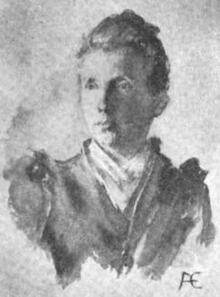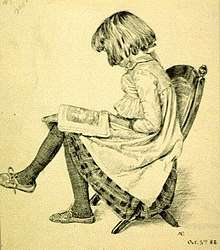Elizabeth Eggleston Seelye
Elizabeth Eggleston Seelye (December 15, 1858 - November 11, 1923) was an American biographer.
Elizabeth Eggleston Seelye | |
|---|---|
 | |
| Born | Elizabeth Craig Eggleston 15 December 1858 Saint Paul, Minnesota, U.S. |
| Died | November 11, 1923 (aged 64) Philadelphia, Pennsylvania, U.S. |
| Occupation | author |
| Language | English |
| Alma mater | Packer Collegiate Institute |
| Genre | biographies |
| Spouse | |
| Relatives | Edward Eggleston (father), Allegra Eggleston (sister) |
Early years and education
Elizabeth Craig Eggleston was born in Saint Paul, Minnesota, Minnesota, December 15, 1858. She was a daughter of Edward Eggleston, the novelist. Her mother, Elizabeth, was of English parentage and of a family with talent for graphic art. Seelye early showed the "book hunger" that characterized members of her family. In 1866, the family removed to Evanston, Illinois, where her father had built one of the earliest kindergartens in America where his children might "be trained".

After they moved to Brooklyn, New York, in 1870, Seelye attended Packer Collegiate Institute, but with her parents dissatisfied, she and her sister were soon taught at home by private teachers. She also was the only child to attend adult classes in French and German at the Brooklyn Mercantile Library.[1]
Her love of reading was illustrated in her writing. Her story "“The A.O.I.B.R." appeared in Harper's Bazaar in 1889 with an illustration of a child reading. The Rockwell Centre for American Visual Studies cites this as a surprisingly early illustration of a girl reading. The subject of girls reading in the illustration by Rosina Emmet Sherwood is thought rare (like the ones in Louisa Allcott's Little Women).[2]
Career
_(14782831055).jpg)
As an adult, she read works of philosophy, natural science and political economy. Her study of the literature of the Middle English period enabled her to supply the editor of the Century Dictionary with 500 new words and definitions. In 1877, she married Elwyn Seelye, and since that time, lived on or near Lake George, New York. She wrote four of the five volumes in the "Famous American Indian Series", Tecumseh (New York, 1878); Pocahontas (New York, 1879); Brant and Red Jacket (New York, 1879), and Montezuma (New York, 1880). Seelye also published The Story of Columbus (New York, 1892), illustrated by her sister, Allegra Eggleston.[3]
Personal life
Seelye was the mother of six children: Allegra (b. 1878), Blanche (b. 1882), Elwyn (b. 1884), Edward (b. 1888), Cynthia (b. 1888) and Elizabeth (b. 1893).[4] She died November 11, 1923, in Philadelphia, Pennsylvania.[5]
Selected works
_(14596325697).jpg)
- Tecumseh and the Shawnee Prophet, 1878
- Brant and Red Jacket, 1879
- Montezuma and the conquest of Mexico, 1880
- The Indian Princess; or, the Story of Pocahontas, 1881
- The Story of Columbus, 1892
- Story of Washington, 1893
- Lake George in history, 1897
- Saratoga and Lake Champlain in history, 1898
References
- Willard & Livermore 1897, p. 639.
- "Women Who Read - The Rockwell Center for American Visual Studies". www.rockwell-center.org. Retrieved 2017-07-19.
- Willard & Livermore 1897, pp. 639-40.
- Foulke, Patricia; Foulke, Robert (November 1, 2014). "Joshua's Rock, Home of the Seelye-Eggleston Family". Retrieved 29 November 2016.
- New York State Historical Association 1924, p. 76.
Attribution

Bibliography
- New York State Historical Association (1924). The Quarterly Journal of the New York State Historical Association. New York State Historical Association.CS1 maint: ref=harv (link)